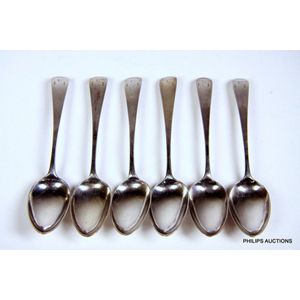Victorian Sterling Silver Bright Cut Teaspoons by John Le Gallais
You must be a subscriber, and be logged in to view price and dealer details.
Subscribe Now to view actual auction price for this item
When you subscribe, you have the option of setting the currency in which to display prices to $Au, $US, $NZ or Stg.
- Sterling Silver - Sterling silver is a mixture of 92.5% pure silver and 7.5% of another metal, usually copper. Fine silver is 99.9% pure silver, and is relatively soft and the addition of the very small amount of copper gives the metal enough strength and hardness to be worked into jewellery, decorative and household objects.
- Foliate - Decorated with leaves or leaf-like forms.
- Hallmarks - A mark stamped on articles of precious metals in Britain, since the 14th century, certifying their purity. It derives its name from the Guild Hall of the Goldsmiths' Company, who recieved its Charter in 1327 giving it the power to assay (test the purity) and mark articles of gold and silver.
The hallmark will consist of several marks, including the:
- silver standard mark, indicating the purity of the metal. Sterling silver is .925 pure silver.
- the city mark indicating the city in which it was assayed eg London, Birmingham, York etc.
- the date mark, usually a letter of the alphabet in a particular font and case,
- a duty mark, indicating whether duty had been paid to the crown, and only in use from 1784 to 1890
The piece may include an additional mark, the maker's mark, although not forming part of the hallmark, will be located in the vicinity of the hallmarks.
Sometimes silver plated items will bear faux hallmarks, often confusing those not familiar with silver markings. - Engraving - The method of decorating or creating inscriptions on silver and other metal objects by marking the surface with a sharp instrument such as a diamond point or rotating cutting wheel.
- Victorian Period - The Victorian period of furniture and decorative arts design covers the reign of Queen Victoria from 1837 to 1901. There was not one dominant style of furniture in the Victorian period. Designers used and modified many historical styles such as Gothic, Tudor, Elizabethan, English Rococo, Neoclassical and others, although use of some styles, such as English Rococo and Gothic tended to dominate the furniture manufacture of the period.
The Victorian period was preceded by the Regency and William IV periods, and followed by the Edwardian period, named for Edward VII (1841 ? 1910) who was King of the United Kingdom and the British Dominions and Emperor of India for the brief period from 1901 until his death in 1910.
This item has been included into following indexes:
Visually similar items

Four Georgian sterling silver soup spoons, late 18th to early 19th century, London, various makers, Old English spoons, each engraved to the terminals & Hallmarked. Silver weight 236gr. Length 21.5 cm

A set of six Georgian sterling silver teaspoons, 1792 London, with maker's marks for Charles Hougham, Old English pattern spoons with contemporary engraved initials to the terminals; hallmarked underside, silver weight 68gr. Length 12.5 cm

A group of six English sterling silver teaspoons, various dates from 1792-1828, all London, the fiddle back spoons from various makers including James Beebe 1792, Sol Royes & James East Dix 1818, possibly William Chawner II 1828, and three others with rubb

A set of six Victorian sterling silver teaspoons, 1851 London, with maker's marks for H.J. Lias & Son, thread edge fiddle pattern spoons, hallmarked underside, silver weight 179gr. Length 14.5 cm
